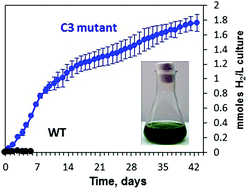Photosystem ratio imbalance promotes direct sustainable H2 production in Chlamydomonas reinhardtii†
Abstract
The green alga Chlamydomonas reinhardtii can photoproduce H2 gas for only a few minutes under anaerobic conditions due to the inhibition of hydrogenase by O2 produced by Photosystem II (PSII). A few days of sustained H2 production can only be achieved when O2 and H2 production are temporally separated under two-stage processes such as sulfur deprivation. Under sulfur deprivation, H2 production is initiated after the over-reduction of the plastoquinone pool and decreased PSII activity in the thylakoid membrane. As a result, activated hydrogenase consumes the excess of electrons produced by PSII [Volgusheva et al., Proc. Natl. Acad. Sci. U. S. A., 2013, 110, 7223]. Here, we report that similar conditions can be achieved by simply altering the ratio between photosystem I (PSI) and PSII. In the C3 mutant of C. reinhardtii, we found a lower PSI/PSII ratio than in the wild type, 0.33 vs. 0.85, respectively. This imbalance of photosystems resulted in the over-reduced state of the plastoquinone pool and activation of hydrogenase in the C3 mutant that allowed the photoproduction of H2 continuously for 42 days. This is an unprecedented duration of H2 production in green algae under standard growth conditions without any nutrient limitation. Photosynthetic electron flow from PSII to hydrogenase was closely regulated during this long-term H2 production. The amount of PSII was decreased and the amount of PSI was increased reaching a PSI/PSII ratio of more than 5 as shown by EPR and fluorescence spectroscopy. This fine-tuning of photosystems allows to sustain the long-term production of H2 in C. reinhardtii by a direct photosynthetic pathway.



 Please wait while we load your content...
Please wait while we load your content...